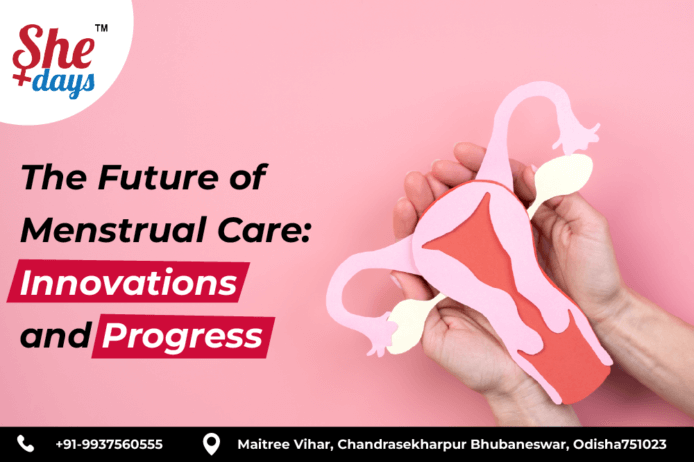The Future of Menstrual Care: Innovations and Progress

The landscape of menstrual care is undergoing a remarkable transformation, driven by technological advancements, a heightened focus on sustainability, and a growing movement for accessibility. In this blog, we will delve into the emerging trends and innovations that are shaping the future of menstrual care. From eco-friendly options to smart technologies and cultural shifts, let’s explore the exciting possibilities that lie ahead.
One of the key aspects driving the future of menstrual care is the increasing demand for sustainable and eco-friendly options. Individuals are becoming more conscious of their environmental impact and are actively seeking alternatives that align with their values. Menstrual cups, washable cloth pads, and period underwear are gaining popularity as reusable options that not only reduce waste but also offer significant cost savings. These sustainable products provide improved comfort and peace of mind for users, as they are free from harmful chemicals and reduce the environmental burden of traditional disposable products. Manufacturers are investing in research and development to enhance the sustainability of menstrual care products. They are exploring innovative materials such as bamboo fibers, organic cotton, and biodegradable polymers to create environmentally friendly options. These materials not only minimize ecological harm but also offer enhanced absorbency and breathability for a more comfortable experience.
The integration of technology in menstrual care is revolutionizing how we manage our periods. Smart menstrual products, such as period tracking apps, wearable devices, and connected pads, offer a range of benefits. These innovations allow users to track their menstrual cycle, monitor flow patterns, and receive personalized insights about their reproductive health. By leveraging the power of data, individuals can make informed decisions and gain a deeper understanding of their bodies.For instance, period tracking apps use algorithms to predict menstrual cycles and provide alerts for upcoming periods, ovulation, and fertile windows. Wearable devices equipped with sensors can track physiological changes, such as body temperature and heart rate, to provide accurate fertility predictions and personalized recommendations. Connected pads with embedded sensors can detect moisture levels and alert users when it’s time for a change, ensuring optimal hygiene and comfort.
In the future, menstrual care products will increasingly prioritize the use of biodegradable and organic materials. Traditional disposable pads often contain plastic and chemicals that can be detrimental to both the environment and our health. By embracing natural and sustainable materials, such as organic cotton and plant-based fibers, manufacturers can offer safer and healthier options. These eco-friendly products ensure a more sustainable and harmonious relationship with the planet while providing users with comfort and peace of mind. Additionally, organic materials are hypoallergenic, reducing the risk of irritation and allergic reactions. The shift towards biodegradable and organic materials in menstrual care products contributes to a healthier ecosystem and a more sustainable future.
The future of menstrual care extends beyond products; it encompasses education and empowerment. Efforts to raise awareness about menstrual health, break stigmas, and provide comprehensive menstrual education will gain momentum. By promoting open and inclusive discussions, individuals can gain a deeper understanding of their bodies, menstrual cycles, and overall well-being. Menstrual health education will cover various topics, including menstrual hygiene practices, the physiological aspects of the menstrual cycle, common menstrual disorders, and self-care strategies. Empowering people with accurate information and resources allows them to make informed choices and take charge of their menstrual health. Additionally, comprehensive education helps combat period-related myths and misconceptions, fostering a positive and empowered attitude towards menstruation.
Addressing menstrual equity is a critical aspect of the future of menstrual care. Many individuals around the world still face barriers in accessing affordable and hygienic menstrual products. Lack of access to suitable facilities, limited financial resources, and social stigma contribute to menstrual inequity.To ensure menstrual equity, efforts are underway to provide free or subsidized menstrual products in schools, workplaces, and public spaces. Nonprofit organizations, government initiatives, and community-driven projects are working towards creating accessible distribution channels and menstrual product donation programs. By addressing the financial and logistical barriers, we can ensure that everyone has access to adequate menstrual care, regardless of their socio-economic background.
Creating lasting change in menstrual care requires cultural shifts and menstrual advocacy. Breaking down the societal taboos and stigma surrounding menstruation is essential for fostering a more inclusive and supportive environment. Menstrual advocacy groups, activists, and influencers are playing a significant role in challenging menstrual shame and promoting open discussions. These advocates share personal stories and experiences, amplifying the voices of those affected by period poverty, inadequate menstrual education, and social discrimination. Through awareness campaigns, media engagement, and policy advocacy, they are driving change at individual, community, and systemic levels. Their efforts are instrumental in shaping public perception, driving policy changes, and fostering cultural acceptance of menstruation.
Advancing the future of menstrual care requires collaboration and partnerships between various stakeholders, including policymakers, non-profits, healthcare providers, and industry leaders. By working together, these entities can drive meaningful change, share resources, and amplify their impact. Collaborative efforts result in the development of comprehensive initiatives, improved accessibility, and the implementation of sustainable practices throughout the menstrual care ecosystem. Healthcare providers can play a crucial role by incorporating menstrual health into routine healthcare services, ensuring that individuals receive accurate information, diagnosis, and treatment for menstrual disorders. Industry leaders can prioritize sustainability, research and development, and ethical manufacturing practices to create safer and eco-friendly menstrual care products. Policymakers can enact legislation to ensure equitable access to menstrual care, implement comprehensive menstrual health education in schools, and support initiatives that address period poverty.
Another aspect shaping the future of menstrual care is the advent of innovative delivery systems and subscription services. Companies are exploring new ways to make menstrual products more convenient and accessible. Subscription-based models allow individuals to customize their product preferences and receive regular deliveries right to their doorstep. This not only saves time and effort but also ensures a consistent supply of menstrual products, reducing the risk of running out during emergencies. Moreover, innovative delivery systems are being introduced, such as vending machines in public spaces, making it easier for individuals to access menstrual products on the go. These advancements in delivery systems and subscription services are transforming the way we manage our periods, providing convenience, and eliminating the stress of shopping for menstrual care products.
Community support and menstrual activism play a pivotal role in driving the future of menstrual care. Grassroots organizations, local initiatives, and online communities are coming together to provide support, resources, and advocacy. They create safe spaces for open discussions, share knowledge about menstrual health, and offer assistance to those in need.
Menstrual activism aims to challenge the social, economic, and cultural barriers associated with menstruation. It strives to create a society that values menstrual health, dismantles taboos, and ensures that all individuals can manage their periods with dignity and respect. By fostering a sense of community and collective action, menstrual activists are instrumental in bringing about change and improving the overall well-being of menstruators.
The future of menstrual care also relies on continuous research and development to enhance existing solutions and introduce advanced technologies. Scientists and innovators are working on developing new materials, improving product designs, and finding innovative ways to address menstrual health concerns. Research focuses on developing biodegradable materials with superior absorbency and comfort, exploring alternatives to traditional menstrual products, and investigating new methods for managing menstrual symptoms and disorders. Advanced solutions, such as drug-releasing patches for pain relief or wearable devices that monitor hormone levels, hold the potential to revolutionize the way we experience menstruation.
In conclusion, the future of menstrual care holds great promise for individuals around the world. Through advancements in technology, sustainability initiatives, education, and community support, the landscape of menstrual care is evolving to better meet the needs of menstruators. The integration of smart devices, biodegradable materials, and innovative delivery systems is making menstrual products more convenient, eco-friendly, and accessible.
Moreover, the focus on education and awareness is breaking down the barriers associated with menstruation, empowering individuals to make informed choices and prioritize their menstrual health. Cultural shifts and menstrual activism are challenging taboos and stigmas, creating a more inclusive and supportive environment for menstruators.
As we look ahead, it is essential to continue the momentum and drive positive change in menstrual care. This includes investing in research and development to improve existing products and develop new solutions, as well as advocating for policy changes that ensure menstrual equity and accessibility.
By working together as a society, we can create a future where menstrual care is not only a basic necessity but also a celebrated aspect of overall health and well-being. Let us continue to break barriers, challenge norms, and prioritize the needs of menstruators, so that everyone can manage their periods with dignity, comfort, and confidence. The future of menstrual care is bright, and by embracing innovation, education, and inclusivity, we can create a world where menstruation is normalized and celebrated.





